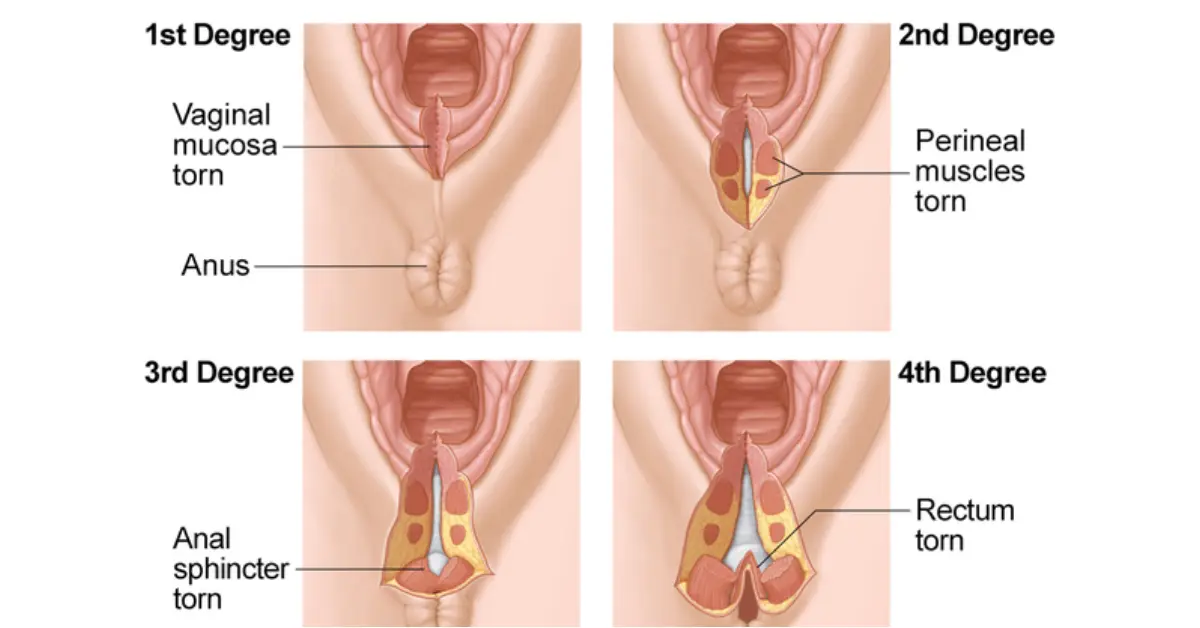
Childbirth is a beautiful and miraculous experience, but it can also be physically challenging. One of the most common physical challenges that women face during childbirth is vaginal birth tears. Vaginal tears occur when the baby’s head is coming through the vaginal opening and it is either too large for the vagina to stretch around or it is a normal size but the vagina doesn’t stretch easily.
In this article on PregnancyBoss, we will discuss the different types of vaginal birth tears and how to care for them.
Related: Bye-Bye C-Section Shelf: 2 Surprising Solutions
What are some statistics on Vaginal Birth Tears?

Statistics on vaginal tears during childbirth vary slightly across different sources. Here are some key statistics based on the search results:
- Up to 9 in every 10 first-time mothers who have a vaginal birth will experience some sort of tear, graze, or episiotomy.
- Up to 90% of people who give birth will have some tearing during a vaginal delivery.
- Perineal tears affect about 80% of women during childbirth, with primiparous women (first-time mothers) being affected more frequently than multiparous women (women who have given birth before).
- In a study conducted on 14 pregnant women, a total of 111 deliveries were recorded with a 12.6% frequency of perineal tears. 71.4% of primiparous women were affected by perineal tears.
- Between 53% and 79% of women will experience some type of tear during a vaginal delivery.
Related: Can Cinnamon Cause A Miscarriage?
Who’s at greatest risk for tearing during birth?
Vaginal tears can occur during any childbirth, but the likelihood increases under the following circumstances:
- Initial experience with vaginal delivery
- Employment of forceps or vacuum extraction during delivery
- Prolonged pushing during labor
- Baby being delivered in a face-up position
- Prior history of an episiotomy
Furthermore, the risk of enduring third- and fourth-degree tears is elevated if your baby has a substantial size (weighing more than approximately 9 pounds) or possesses a large head circumference (exceeding 37 cm or roughly 15.5 inches).
Experiencing a vaginal tear during one delivery does not necessarily predict a recurrence in subsequent births. Nevertheless, if you have previously encountered a severe tear, the possibility of encountering another tear in the future remains a concern. It is advisable to engage in discussions with your medical practitioner or midwife to explore methods of minimizing such risks. Additionally, if the risk is deemed substantial, the option of undergoing a C-section can be considered.
Related: What Are The Natural Cures For Female Dryness?
What are different Vaginal Birth Tears?
Perineal Tears

These tears occur in the tissues and muscles situated between the vaginal opening and the anus. These tears are categorized into four different degrees, each with its own timeline for healing and rehabilitation.
The most prevalent are the First Degree and Second Degree Tears, happening to around 94% of individuals who experience such tears.
First-Degree Tears
First-degree tears are the least severe type of vaginal birth tear. They involve the skin between the vaginal opening and the rectum and the tissue directly beneath the skin, which is called the perineum.
These tears usually heal on their own within a few weeks of birth. However, you may experience some pain or discomfort during this time.
Second-Degree Tears
Second-degree tears are deeper than first-degree tears and affect the muscle of your perineum.
These tears may require stitches to heal properly. You may experience some pain or discomfort for a few weeks after the stitches are placed, but the pain should gradually decrease over time.
Third-Degree Tears
Third-degree tears are more severe than second-degree tears and involve the muscle that controls your anus (the anal sphincter).
These tears require stitches and may take longer to heal than second-degree tears. You may experience pain or discomfort for several weeks after the stitches are placed.
Fourth-Degree Tears
Fourth-degree tears are the most severe type of vaginal birth tear. They involve the anal sphincter and the tissue that lines the rectum.
These tears require immediate medical attention and surgery to repair. Recovery from a fourth-degree tear can take several months.
We think everyone should see a pelvic floor PT after any birth but ESPECIALLY for those who had a 3rd and 4th-degree tear.
Labial Lacerations
Labial lacerations are tears in the labia, which are the folds of skin on either side of the vaginal opening. These tears can be caused by the way the baby’s head comes out during delivery. Labial lacerations are usually minor and heal on their own within a few weeks.
Cervical Lacerations
Cervical lacerations are tears in the cervix, which is the lower part of the uterus that opens into the vagina. These tears can occur during childbirth if the cervix is not fully dilated. Cervical lacerations are usually minor and heal on their own within a few weeks.
Vaginal Wall or Internal Tears
Vaginal wall or internal tears are tears along the vaginal wall inside of the vaginal opening. These tears are sometimes called sulcus tears as well. These tears can be caused by the way the baby’s head comes out during delivery. Vaginal wall or internal tears are usually minor and heal on their own within a few weeks.
Clitoral Tears
Clitoral tears are tears in the clitoral hood or the clitoris itself. These tears are rare and usually occur in women who have had a previous clitoral injury or surgery. Clitoral tears can be painful and may require stitches to heal properly.
Urethral Tears
Urethral tears are tears in the urethra, which is the tube that carries urine from the bladder to the outside of the body. These tears are rare and usually occur in women who have had a previous urethral injury or surgery. Urethral tears can be painful and may require stitches to heal properly.
Related: How Do Celebrities Lose Weight Fast After Pregnancy?
What steps can be taken to minimize the risk or severity of vaginal birth tears?
Here are some steps you can take to minimize the risk or severe vaginal birth tears.
- Perineal Massage: This technique involves massaging the perineum in the weeks leading up to childbirth. It can help to stretch and prepare the area for delivery.
- Positioning: Certain birthing positions, like squatting or using a birthing bar, can help open up the pelvic area and reduce the chances of severe tearing.
- Warm Compresses: Applying warm compresses to the perineum during the pushing stage can help relax the tissue and reduce the risk of tearing.
- Slow and Controlled Pushing: Pushing slowly and effectively as guided by your healthcare provider can give your perineum time to stretch gradually.
- Episiotomy: In some cases, a controlled incision called an episiotomy might be made to prevent unpredictable tearing. However, this practice is becoming less common and is usually only performed if necessary.
Related: What To Say To Someone Who Had A Miscarriage?
How to care for Vaginal Birth Tears?

Caring for vaginal birth tears is important to ensure proper healing and to prevent infection. Here are some tips for caring for vaginal birth tears:
- Keep the area clean and dry.
- Use a peri-bottle to clean the area after using the bathroom.
- Use a sitz bath to help soothe the area.
- Apply ice packs to the affected area to help reduce swelling.
- Take pain medication as prescribed by your healthcare provider.
- Avoid strenuous activity and heavy lifting until your healthcare provider gives you the okay.
- Do pelvic floor exercises to help strengthen the muscles in the area.
Conclusion
Vaginal birth tears are a common occurrence, but there are ways to prevent and manage them. Some of the ways to prevent tears include performing perineal massage, practicing birthing positions ahead of time, and making a perineal tear prevention plan. During childbirth, aiming for more controlled and less expulsive pushing can also decrease the risk of severe tears. If a tear does occur, there are several at-home treatments that can be done to reduce discomfort. It is important to seek medical attention if the tear is severe or if there are any signs of infection.
Frequently Asked Questions (FAQs)
What causes vaginal birth tears?
Can vaginal birth tears be prevented?
How can vaginal birth tears be managed?
If a tear does occur, there are several at-home treatments that can be done to reduce discomfort, such as using a peri-bottle filled with warm water to rinse the area clean after using the bathroom and gently patting the area dry with toilet paper. It is important to seek medical attention if the tear is severe or if there are any signs of infection.
What are the risks of inadequate treatment of vaginal birth tears?
Inadequate treatment of vaginal birth tears can cause chronic perineal pain and can affect a woman’s sex life. It is important to seek medical attention if a tear is severe or if there are any signs of infection.












